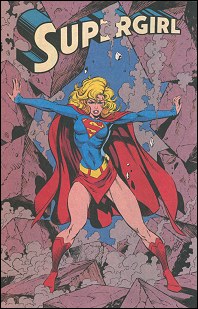Publication History
Following the death of the original Supergirl in the Crisis on Infinite Earths, DC Comics introduced a new Supergirl named Matrix who was a shapeshifting being created from the genetic matrix of another universe’s Lana Lang. She appeared as a minor character in Superman books for a number of years before gaining her own long-running series in 1996.
The 1986 miniseries The Man of Steel retold Superman’s origin story for the new timeline created after the Crisis on Infinite Earths. DC editorial policy dictated that Superman would be the sole survivor of Krypton and that Kara Zor-El did not exist in this universe. Gone were Krypto, the bottled city of Kandor, and Superman’s adventures as Superboy. Elements that had made the Superman mythos so rich for four decades were rewritten and forbidden from even being mentioned in publisher’s new universe.
Yet only three years after Kara Zor-El being declared persona non grata, DC Comics introduced a new character to replace her in the three-part “Supergirl Saga” (Superman #21, Adventures of Superman #444, Superman #22, 1988). Superman met a woman calling herself Supergirl, closely resembling early 1980s Kara, who brought the news of a parallel Earth hidden away in a “pocket dimension” that was being threatened by evil Kryptonians and needed Superman’s help. This Earth had only one superhero, Superboy, who mysteriously disappeared 10 years earlier. Lex Luthor and his wife, Lana Lang, fought bravely in the resistance against the Kryptonians, but Lana was killed and their world seemed doomed without a superhero to defend it. In honor of his wife and in memory of Superboy, Lex created an artificial shapeshifting life-form named “Supergirl” based on his wife’s form—specifically her “molecular matrix”—and imprinted her with Lana’s memories.
The fledgling superheroine travelled to Earth Prime to bring back Superman in hopes that, together, they might defeat the super villains. But in the battle that followed her world was completely destroyed and Matrix Supergirl nearly died. Superman brought the gravely injured Matrix back to his Earth and placed her with the Kents to recover. Soon she would strike out on her own, but it would take some years for the new Supergirl to truly find herself.
Between the 1988 origin story and the start of the 1996 Supergirl series, Matrix Supergirl starred in a one-shot called Supergirl & Team Luthor, a four-issue Supergirl miniseries, and made numerous guest appearances in the Superman comics (see Matrix Supergirl Comics). She began a relationship with Lex Luthor II (Lex Luthor in disguise), believing him to be like the Luthor who created her. Once she discovered Luthor’s true nature she severed relationship. She drifted, a superhero without a purpose or home. The implanted memories of her home planet faded, and she found herself a superhero with no secret identity and few real ties to her adopted home. Matrix faced the existential crisis of a superhero without an identity: a creation of men, she struggled to find her purpose in this world. She would eventually find that purpose in saving the life of a human girl named Linda Danvers.
Fictional Biography
From The Essential Superman Encyclopedia (Robert Greenberger and Martin Pasko, Del Rey (USA) and Titan Books (UK), 2010).
In the world after reality was altered, Superman was the sole survivor of Krypton, and as a result Kara did not exist. Superman was baffled when a young blond woman was found frozen in a block of ice in the Arctic (Superman [second series] #16, Apr 1988). When she was recovered, she explained that she was actually from a realm know as the Pocket Universe. Superman knew that the Time Trapper had stolen a sliver of pre-Crisis time and formed this universe, where Earth-1 effectively remained. When that universe’s Superboy died, things began to change. That reality’s General Zod and two other Phantom Zone villains escaped and laid waste to the world, one without super heroes. Without a Superboy to twist his mind, Lex Luthor worked to save humanity. He invented an artificial life-form made from a “protoplasmic matrix”. When it took human form, it followed its programming to resemble Lana Lang, the love of Luthor’s life and one who had died. The Matrix, however, retained all of Lana’s memories thanks to the dead woman’s synaptic pathways being copied to the new life-form.
Matrix was also programmed to approximate the Man of Steel’s powers and abilities. Matrix could fly, she had super-strength and other attributes, but she also could shape-shift, cloak herself to near-invisibility, and perform telekinesis. She tried to fight the villains on her own but was beaten, so Luthor dispatched her to the main universe to bring back Superman.
The Man of Steel arrived and fought the villains, recognizing the perilous circumstances. Breaking his vow never to kill, he ended their lives and brought the severely damaged Matrix back to his reality. He took her to the Kent family farm, where Jonathan and Martha Kent agreed to nurse her back to health. Ma Kent decided she needed to be called something other than Matrix and shorted it to “Mae” (Superman [second series] #21-22 and The Adventures of Superman #444—both Sep-Oct 1988).
While she healed, Superman had tremendous difficulty coping with his actions and wound up exiling himself from Earth for a year. The healed Matrix decided she would help cover for him by taking his form and using her powers to protect Metropolis and the world. By the time her mentor returned, she had come to think of herself as Superman and Clark Kent and had to be shocked back to her senses. Shortly afterward, she fled Earth for a time to regain her sense of self (Action Comics #644, Aug 1989).
She did not return to Earth until the planet came under attacke by Brainiac. Superman happily welcomed her home, and she chose to remain (Action Comics #676, Apr 1992). During her return, Matrix fell in love with Lex Luthor, who at the time was passing himself as his son but was actually inhabiting a cloned body. She once more wore the costume the Pocket Universe’s Luthor gave her and proudly took the name Supergirl. In her new role, she battled crime, fought at Superman’s side, moved in with Luthor, and worked with his armored mercenaries Team Luthor.
Things changed when Luthor kept her from aiding Superman in his cross-country struggle against the murderous Doomsday. When the fight reached Metropolis, she defied her lover and joined the fray, only to receive a mammoth blow that reverted her to to her protoplasmic form (Superman: The Man of Steel #19, Jan 1993). In the wake of Superman’s death, she continued to look after Metropolis and bonded with Superboy, the clone of Superman (and—unbeknownst to her—Luthor). When Superman was revived, she shifted to Clark Kent, explaining away his absence by arranging to be found in a well-stocked cellar (Action Comics #692, Oct 1993).
She was devastated to learn that Luthor had secretly been building an army of Supergirl clones. Worse, he was not who he appeared to be. She destroyed the lab and her genetic copies, leaving Luthor for good (Supergirl [third series] #1-4, Feb-May 1994). She then had an unsettling encounter with the Teen Titan Raven that left the heroine implanted with a demon seed to help Raven’s father Trigon the Terrible gain power on Earth (Showcase ’95 #2, Feb 1995). She managed to free herself and worked with Arsenal’s Teen Titans to stop Raven. He offered her membership, which she accepted (New Titans #121, May 1995). It wasn’t long before the team disbanded, however, and Matrix’s life changed forever.

